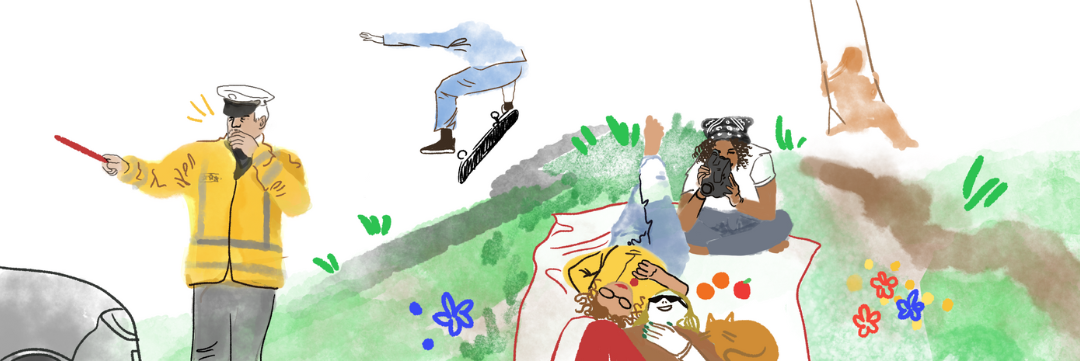
Ave Habakuk, co-founder of NGO Elav Tänav
When I was 10, I went to tennis practice. The practice took place about 500 meters from my home, and I walked to the practice and back home on my own. I remember that on this journey, I had two favorite spots that made the walk exciting. On the way, there was a low dilapidated pre-war stone wall, which ran parallel to the sidewalk, and I preferred to walk on this rather than on the sidewalk. The second spot was a muddy section where someone had sprinkled strange colored pieces of plastic in the shape of lips and hearts and rings. It was exciting, looking down, to wonder if I could find a new piece today and to think about why they were here and how they got here. Now, a part of the wall has been replaced with a solid wooden fence and the mud track has been resurfaced, and the amount of car traffic on the street has increased multifold. The space looks cleaner, but it is no longer half as varied and stimulating, and the 10-year-old me would probably find this journey a bit more boring. What if someone had also asked about my spatial experience and the whole street had been designed with my 10-year-old needs in mind?
Every time we leave our homes, we find ourselves in public space. Public space is not just the streets we use for moving from point A to point B. A good public space is also a space for being. It is a place where a community grows, where people from different backgrounds meet, where both 8-year-olds and 80-year-olds feel good. Unfortunately, things with public space are not good in Estonia. Keit Parts, the Head of the Accessibility Task Force set up at the State Chancellery, has stated that most of the spaces, experiences, and services around us have been created with the needs of an average person in mind, who is a fit right-handed middle-aged adult of an average height. However, average persons make up only 49% of the Estonian population. How can we make public space more responsive to the needs and expectations of children and young people?
It is definitely worth asking children and young people themselves! We still have a lot to desire in terms of participation and initiative based spatial use – streets are mostly planned for car traffic, and community expectations are often seen as secondary, municipalities involved in creating public spaces are sometimes skeptical and sometimes simply lack the experience and skills to implement community initiatives. However, one should not be intimidated by that. Let’s grow together! Public space belongs to all of us, and it is a great place for practicing democracy with young people, and where there is also a great lack of voice and perspective from non-average people.
We are quite well equipped with playgrounds where younger children can spend time, but there is much less public space suitable for teenagers. Susannah Walker noticed that the public space for older children is more pro-competitive and mostly focuses on the interests of boys. Young girls feel comfortable in a space where they can just be, learn and experiment with roller skating, for example, without being given unwanted attention. They also prefer places where they can listen to music with friends without buying an expensive festival ticket. These observations gave birth to the charity Make Space for Girls, which focuses on meeting the spatial needs of teenage girls. For example, teenage girls have received very warmly swings hung in public spaces, the surrounding environment of which did not necessarily indicate that they were intended for children to play.
Children and young people are very space-conscious and space-sensitive. As they do not have a driver’s license, they move a lot in urban space on their own; they notice, see and feel urban space directly. Children and young people not only move around in public spaces but also need places where they can comfortably spend time and where they can grow and experiment. “What kind of public space do you want?” is a difficult question that even we find difficult to answer. A better starting point is to look at how young people currently perceive space – to provide vocabulary for talking about space, to help them find the most acute problems, to think together about possible solutions, and to find the right people with whom young people could have a dialogue.
Any public space dialogue could start with fieldwork. For example, going together to explore a specific place, taking pictures of it, describing the good things that are already there, and documenting the current concerns. One of the ways I have gathered young people`s public space experiences is as follows. I asked young people to draw two dots on a blank piece of paper and write “home” on one and “school” on the other, and then to freely draw a line from one point to the other. Then I asked the young people to close their eyes for a moment and, in their minds, walk through the path from the door of their home to school. Then I asked them to draw two x`s on the line, one to mark the section they liked the most and the other to mark the most unpleasant place on the school road. Finally, I asked the young people to share which places they marked and why. A similar exercise can be done, for example, by focusing on time spent after school. For a more vivid description the path could be walked through together or with a small group.
Cool examples of fieldwork with children are a cooperation of VIVITA Creativity Accelerator with Prisma, a project of the Center for Applied Anthropology of Estonia with the Estonian Health Museum, and a study commissioned by the State Chancellery on concerns about children’s accessibility in urban space. After collecting fieldwork materials, they can be analyzed together with the young people – find common problems and start looking for solutions. Solutions can be prototyped, for example, by drawing, constructing from legos or cardboard, and visualizing in Minecraft. The entire process, from the first fieldwork to the prototypes, should be documented both in pictures and in words, and a short presentation should be put together. This makes it easier for young people to make their concerns and suggestions clear to third parties.
What to do with the gathered knowledge?
- You can probably try some solutions by yourselves right away. A public space can be temporary, and if a concern arose, for example, if there is not enough space to practice cycling or rollerblading in peace, this space can be created by temporarily closing the street to traffic. To temporarily close the traffic, one should contact the local government, who can help with that. In many parts of the world, temporary closure of streets to create room for playing is a regular activity.
- If a place belonging to a company turns out to be the problem, young people can be encouraged to contact the company and make suggestions. For example, based on the suggestions of cyclists, Coop and Rimi have improved bicycle parking options at several shop locations. Perhaps the shops` surroundings could be more comfortable for children and young people as well?
- Inclusive budgets are becoming more common – youth-initiated public space innovations can find support in this format.
- Public space initiatives are great for practicing participatory democracy! In addition to national initiatives, the Citizen Initiative Portal can also be used to create proposals to the local governments. To submit a proposal, it must be signed by 1% of the local voting population, and initiatives can be created and signed by young people who are at least 16 years old.
- Local governments, which are responsible for the planning, construction, and maintenance of streets, parks, and squares, have a major role in creating public spaces. Local governments can also set various standards for real estate developers, to regulate, for example, how much parking spaces and greenery must be developed or how much the developer must contribute to public transport infrastructure. Therefore, it is also worth addressing people’s representatives directly with the proposals.
A Commentary to the Article: Opportunities for Dialogue: Young People and Urban Space

Kaarel Paal, student of applied physics in TalTech
I believe that high-quality urban space, as seen from pedestrian viewpoint, is necessary for everyone, either young or old. We all need places where there would be good and pleasant to be, where one could walk peacefully, spend time with friends, sit on a bench and read. Besides spending free time, urban space should offer people the opportunity to move from one point to another and to do so while disturbing their fellow citizens as little as possible. If I want to get from point A to point B, then why should people living on my trajectory suffer because of it?
Unfortunately, these two things – being comfortable and transport sparing others – are something that Estonian cities cannot yet do well. We consider car traffic to be the most important thing. In terms of spatial use, this is, unfortunately, a terribly inefficient mode of transport, which also produces a lot of noise. This immediately creates a problem: if we favor cars on the streets, the streets will become narrow sidewalks for everyone else. The scanty remaining space and the noise of passing cars equate to the loss of comfort.
I’m not saying cars are bad. On the contrary, car is a very good invention, but it is simply misused. Cars are well suited for longer journeys or when one needs to carry more stuff than it would be possible by bus. However, a car should not be the tool most people use for urban travel, simply because there is no space for everyone to drive around alone, not to mention urban space and sustainability.
But why should young people have more say about urban space? The answer is very simple: young people have lived too little to be used to the current poor solutions. They have a less fixed idea of where in the city center a pedestrian has to skip from curb to curb on a narrow sidewalk so that the driver could step on it and race at 60 km/h in a nice wide lane. At the same time, I think it is not always necessary to involve young people in order to create a pleasant urban space. However, young people are a good yardstick for assessing urban space: if we see few young people on the streets just hanging out, then it means that it is not good to be on those streets.
There is a growing tendency for children not to move around enough or to spend time outdoors. Computers and telephones are mostly blamed for this, and the common solution is to take children to a sports practice. I am certain that the root of the evil is in fact a car-centric urban space that does not favor spending time outside. Whereas, there are playgrounds here and there for kindergarteners, there is nothing to keep the little older city dwellers outside: there is asphalt and noise everywhere, the yards are full of parked cars. Cities are not destined to be like that. Of course, there are still some nice places even today, but there should be many more. It’s great when a new pump track is opened, or a gym is renovated, but first and foremost, we should make our streets pleasant, because they are used by everyone.
And it is probably not necessary to add that high-quality urban space serves not only children and young people but all of us.
The cover image was designed by young Estonian artist Margaret Pütsepp.

